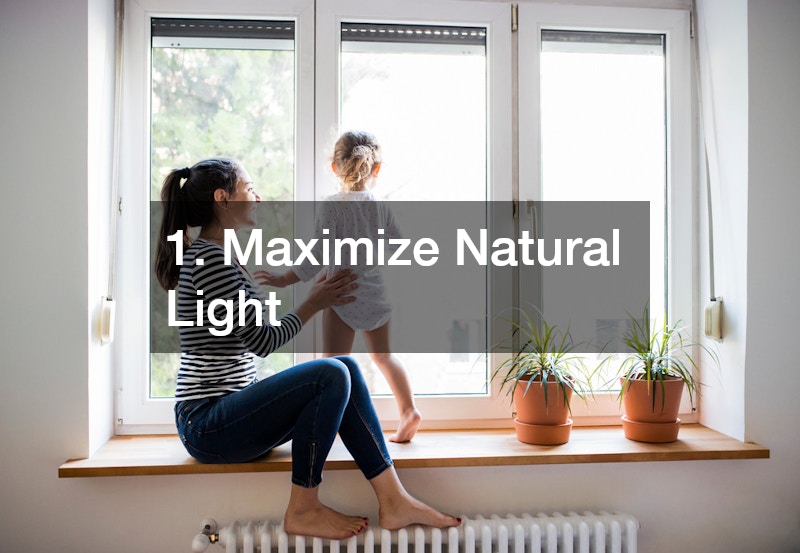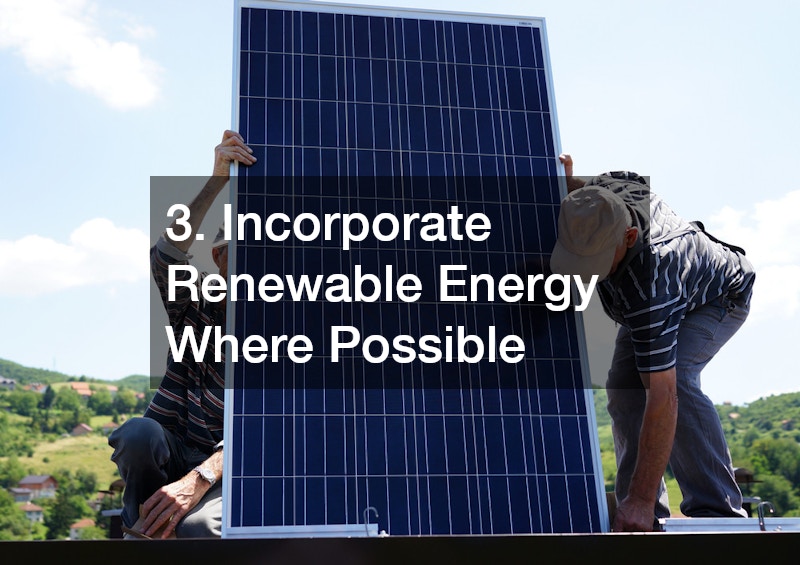
Making your home greener doesn’t have to be complicated, expensive, or reserved for major renovations. In fact, even small, thoughtful upgrades can have a surprisingly big impact on your energy efficiency, comfort, and long-term savings. Simple changes like improving insulation, optimizing natural light, or updating older fixtures can reduce your household’s environmental footprint while making your living space more enjoyable every day. Over time, these eco-conscious choices add up, saving you money on utility bills and contributing to a healthier home environment.
From subtle adjustments, like adding shading solutions or repairing minor drafts, to full-scale remodeling projects, there are numerous ways to create a more sustainable home. What’s great is that these changes don’t have to compromise style or comfort — many eco-friendly solutions enhance both aesthetics and functionality.
Whether you live in a cozy apartment, a traditional house, or a sprawling property, the following ten renovation ideas are flexible and adaptable enough to suit any home. Each suggestion can be tailored to your budget, space, and lifestyle, making it easy to take steps toward a greener, more energy-efficient, and comfortable living environment.
1. Maximize Natural Light

Bringing more natural light into your home is a simple yet powerful way to make it feel brighter, healthier, and more energy-efficient. Large windows, strategically placed mirrors, or even small skylights can illuminate your space while reducing reliance on artificial lighting during the day. Upgrading your windows or making minor glass repairs can also improve insulation, keeping your home warmer in winter and cooler in summer.
Even small adjustments, like rearranging furniture to let sunlight flow through rooms or removing heavy curtains that block light, can create noticeable differences. Natural light doesn’t just save energy — it improves mood, boosts productivity, and makes your home feel more inviting. For spaces that lack direct sunlight, light-colored walls, reflective surfaces, or strategically placed indoor plants can help distribute light more effectively throughout the room.
2. Install Flexible Shading Solutions
While letting in sunlight is important, controlling how it enters your home is equally essential. Interior shutters, blinds, or shades give you flexibility to adjust light and temperature naturally. Plantation-style shutters are a particularly effective option: they allow you to filter sunlight, maintain privacy, and reduce glare, all while being durable and long-lasting.
Shading solutions can help protect furniture, flooring, and artwork from fading while minimizing the demand on heating and cooling systems. Layering interior plantation shutters with light-filtering curtains or automated shades allows for precise control over temperature and light throughout the day. By choosing sustainably sourced materials, you can enjoy all these benefits while supporting eco-conscious manufacturing practices. Even in smaller spaces like apartments, flexible shading solutions can make a noticeable impact on comfort and energy use.
3. Incorporate Renewable Energy Where Possible

Renewable energy is one of the most impactful ways to reduce your home’s environmental footprint. Solar installations, even on a modest scale, can offset electricity usage and decrease reliance on the grid. For those with limited roof space, smaller solar setups or community solar programs can still provide meaningful energy savings.
Pairing renewable energy with smart home systems, energy-efficient appliances, and LED lighting maximizes the benefits. Consider storage options, like batteries, to use solar power even when the sun isn’t shining. Over time, renewable energy not only lowers utility bills but can increase property value and appeal to future buyers. Whether your home is large or small, a solar installation is a practical way to make a lasting, positive impact on the environment.
4. Use Sustainable Materials in Key Spaces
Choosing sustainable materials for major renovations is one of the most practical ways to make your home eco-friendly without sacrificing style or functionality. In specific projects to overhaul key spaces like a kitchen remodeling, thoughtful selections can make a significant difference. For example, reclaimed wood for cabinets or shelving adds character and warmth while keeping usable materials out of landfills. Recycled countertops and tiles offer modern designs with a lower environmental impact, and low-impact paints or finishes reduce exposure to harmful chemicals while improving indoor air quality. Even smaller material choices, such as opting for durable flooring, long-lasting cabinetry, or hardware made from responsibly sourced metals, contribute to a greener, more resilient home.
Beyond aesthetics, sustainable materials often outperform traditional options in longevity and maintenance. Durable finishes, high-quality cabinetry, and water-resistant surfaces reduce the need for frequent replacement or repairs, which in turn minimizes construction waste and energy use over time. Water-saving fixtures, like low-flow faucets, dual-flush toilets, and efficient showerheads, conserve resources while maintaining practicality and convenience.
Thoughtful planning and material selection also allow you to combine style with sustainability seamlessly. For instance, choosing natural or recycled materials in patterns and colors that complement your home ensures your renovations are visually appealing while being environmentally responsible. By prioritizing durability, resource efficiency, and low-impact production, you create spaces that are both beautiful and functional, supporting a healthier home environment and a reduced ecological footprint for years to come. Even small, intentional choices made during renovations can have lasting positive effects on your home’s sustainability, energy efficiency, and overall comfort.
5. Upgrade Climate Control Systems

Efficient heating and cooling systems are essential for maintaining comfort, reducing energy costs, and lowering your home’s environmental impact. A well-functioning HVAC system ensures your living spaces remain at the ideal temperature year-round without wasting energy. Scheduling professional HVAC services for inspections, routine maintenance, and timely upgrades is key to keeping your system operating at peak performance. Modern units often include programmable settings, smart thermostats, or automated controls, allowing you to adjust temperatures based on occupancy, time of day, or seasonal needs, which can significantly reduce unnecessary energy use.
Beyond energy efficiency, a properly maintained HVAC system improves indoor air quality. Clean ducts, high-quality filters, and routine inspections help reduce dust, allergens, and other pollutants circulating in your home, creating a healthier environment for family members. Systems that include humidity control or ventilation improvements also prevent mold growth and structural damage, adding longevity to both your equipment and your home.
Advanced features like zoning systems allow you to heat or cool only the rooms you’re using, rather than the entire house, further cutting energy consumption and costs. Even small adjustments, such as sealing leaks in ductwork, insulating vents, or replacing old filters, can dramatically improve comfort and efficiency.
6. Choose Durable and Reflective Roofing
Your roof is one of the most influential elements when it comes to effectively maintaining a comfortable and energy-efficient home. Reflective materials, metal roofing, or green roofs help regulate indoor temperatures by reducing heat absorption and improving insulation. Sustainable residential roofing options, such as recycled shingles or long-lasting metal, also reduce maintenance needs and waste over time.
Vegetated or “green” roofs provide extra insulation, absorb rainwater, and even support biodiversity. Light-colored coatings reflect sunlight, cutting cooling costs during hot months. When paired with properly insulated walls and attic spaces, sustainable roofing upgrades can transform your home into a more energy-conscious, resilient living space.
7. Improve Indoor Air Quality

Clean air is essential for both health and sustainability. Poor indoor air quality can increase the need for heating and cooling and affect your well-being. Professional air quality services can help identify issues like moisture, allergens, or chemical pollutants, giving you the information you need to make effective improvements.
Upgrades such as advanced filtration, better ventilation, or using non-toxic paints and finishes improve air quality and comfort. Indoor plants known for their air-purifying properties can complement these efforts while adding a natural aesthetic. Balanced airflow reduces stress on HVAC systems, improves energy efficiency, and ensures a safer, healthier environment for your family.
8. Design an Eco-Friendly Outdoor Space
Your outdoor space is an opportunity to combine beauty, functionality, and sustainability. Eco-conscious landscaping uses native plants, water-efficient irrigation, and permeable surfaces to conserve resources and reduce maintenance. Thoughtful planning can also provide natural shade, reducing indoor cooling needs during the summer months.
Rain gardens, composting areas, and strategically placed trees improve water management and support local wildlife. Outdoor solar lighting or motion-sensor fixtures provide safety and convenience while reducing electricity use. Collaborating with a landscape designer can help create a cohesive, sustainable environment that complements your indoor renovations and supports a greener lifestyle.
9. Smart Electrical and Lighting Upgrades
As you may know, updating your electrical system can significantly reduce energy use while improving convenience. Energy-efficient lighting, timers, and smart outlets allow you to control electricity consumption and reduce waste. Automated systems ensure lights and appliances operate only when needed, supporting sustainability without sacrificing comfort.
Reaching out to your local electrical company about upgrades can also help prepare your home for future needs, including renewable energy integration or smart home technology. Motion sensors, programmable outlets, and energy-efficient devices provide both efficiency and safety. These changes are subtle but can make a noticeable difference in your home’s overall energy footprint and functionality.
10. Focus on Small, High-Impact Fixes
Some of the most effective eco-friendly upgrades are also the simplest, proving that you don’t always need major renovations to make a meaningful impact. Minor glass repairs, for example, can prevent heat loss in winter and reduce drafts in summer, improving comfort while lowering energy bills. Sealing leaks around windows and doors, replacing worn insulation, or adjusting misaligned doors can similarly enhance your home’s energy efficiency immediately. These small, often overlooked fixes can complement larger projects like window replacement, HVAC upgrades, or roofing improvements, amplifying the benefits of bigger investments.
Even routine maintenance tasks, such as installing or replacing weather stripping, caulking gaps, tightening loose fittings, or lubricating hinges, can prevent energy loss and extend the life of your home’s existing systems. For older homes, simple checks like inspecting attic insulation or patching minor cracks around vents and ducts can make a surprising difference in overall energy use. Over time, these incremental changes accumulate, creating a more comfortable, efficient, and environmentally responsible living space without requiring extensive construction or a large budget.
The beauty of these small adjustments is that they are accessible to virtually every homeowner, regardless of property size or layout. They provide immediate, tangible results and set the stage for larger eco-friendly renovations. By tackling minor improvements consistently, you establish a foundation for long-term sustainability and create a home that feels both modern and energy-conscious, proving that even modest efforts can have a significant environmental impact.
Bringing It All Together
Eco-friendly home improvements don’t have to be dramatic, costly, or time-consuming to make a real difference. Even small, thoughtful upgrades can add up to meaningful energy savings, increased comfort, and a healthier living environment. Whether it’s maximizing natural light to reduce reliance on artificial lighting, improving airflow to make your heating and cooling systems more efficient, integrating renewable energy sources, or adding smart systems to manage your home’s energy use, each improvement contributes to a more sustainable, efficient, and comfortable home.
The key is combining multiple approaches in a way that fits your lifestyle and space. Interior upgrades like sustainable materials, durable finishes, or flexible shading solutions can work in harmony with larger systems, such as heating, cooling, and energy production, to create a cohesive, high-performing home. Outdoor elements, including thoughtful landscaping, water-efficient irrigation, and solar-powered lighting, further enhance your home’s sustainability while improving curb appeal and usability.
Even minor changes, like sealing drafts, repairing small areas of glass, or updating electrical fixtures, accumulate over time. These incremental improvements complement bigger renovations and often cost far less than full-scale projects while providing noticeable benefits. Over months and years, small steps can lead to significant reductions in energy consumption, lower utility bills, and a smaller environmental footprint — all while maintaining comfort, style, and functionality.
No matter the size, layout, or style of your home, these ten eco-friendly renovation ideas offer a roadmap for making your space more sustainable, healthier, and more enjoyable. By approaching improvements thoughtfully, prioritizing efficiency, and blending style with function, you can create a home that not only serves your family today but also supports long-term environmental responsibility. Living sustainably doesn’t have to be overwhelming — it can be a rewarding journey that enhances every corner of your home while contributing positively to the planet.





